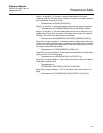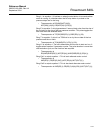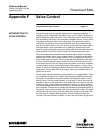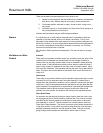
Reference Manual
00809-0100-4696, Rev AA
September 2004
Rosemount 848L
www.rosemount.com
Appendix F Valve Control
Introduction to Valve Control . . . . . . . . . . . . . . . . . . . . . . page F-1
INTRODUCTION TO
VALVE CONTROL
Industrial valves have two general classifications, regulating and block. A
regulating valve is designed to be stable at any one of a nearly infinite set of
positions between open and closed. They are mostly used in control loops so
that nonlinearity and friction are corrected by feedback control. A block valve
is designed to be either tight shut or wide open. They are mostly used to
change the configuration of process equipment, such as a heat exchanger
that can be used to heat or cool, but not both at the same time. Block valves
configure steam in and condensate out for heating or chilled brine in and
return for cooling. Regulating valves are being used as block valves when the
actual position of the valve must be known, but analog outputs are used.
Block valves generally have some kind of switch that is closed in the open
position and another switch for the closed position. These are called confirm
contacts even if they are proximity switches. The valve position is unknown
when neither switch is closed. If the valve actuator has adequate power then it
is rare to find both switches open, except for a period of time known as the
travel time when the valve is moving from one position to the other. Actuators
can be hydraulic pistons, pneumatic pistons or diaphragms, or motor driven
screws, in order of increasing travel time. More than 80% of the actuators use
compressed, oil and water free air for power. Valves are referred to as air to
open or air to close.
A block valve may be controlled by push buttons or by a toggle switch. There
is no contactor as there is for a motor. Permissive and interlock circuits may
be applied. The actuator may require power to be applied to open it, with a
spring to return it to the closed position, or vice-versa. A block valve may be
required to stay in its last position on air or power failure, so there is one pilot
actuator to open it and another pilot actuator to close it. The pilot actuator is
not usually designed for continuous power, so a few second pulse may be all
that is required. The actuator is called a pilot because it just directs the flow of
fluid power, as by pushing a spool valve from one side to the other. The spool
valve directs the main flow to one side of the main actuator or the other, like
the pilot valve in a power steering system. Two pilot solenoid valves are
required if the spool latches in position, or one if the spool has a spring return.


















